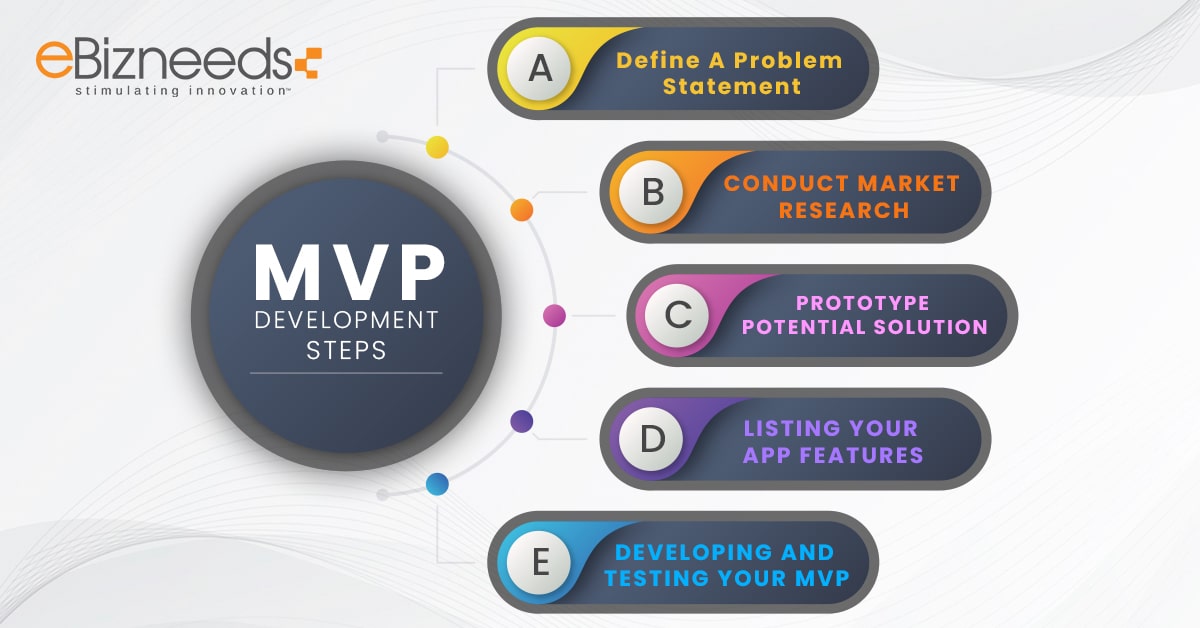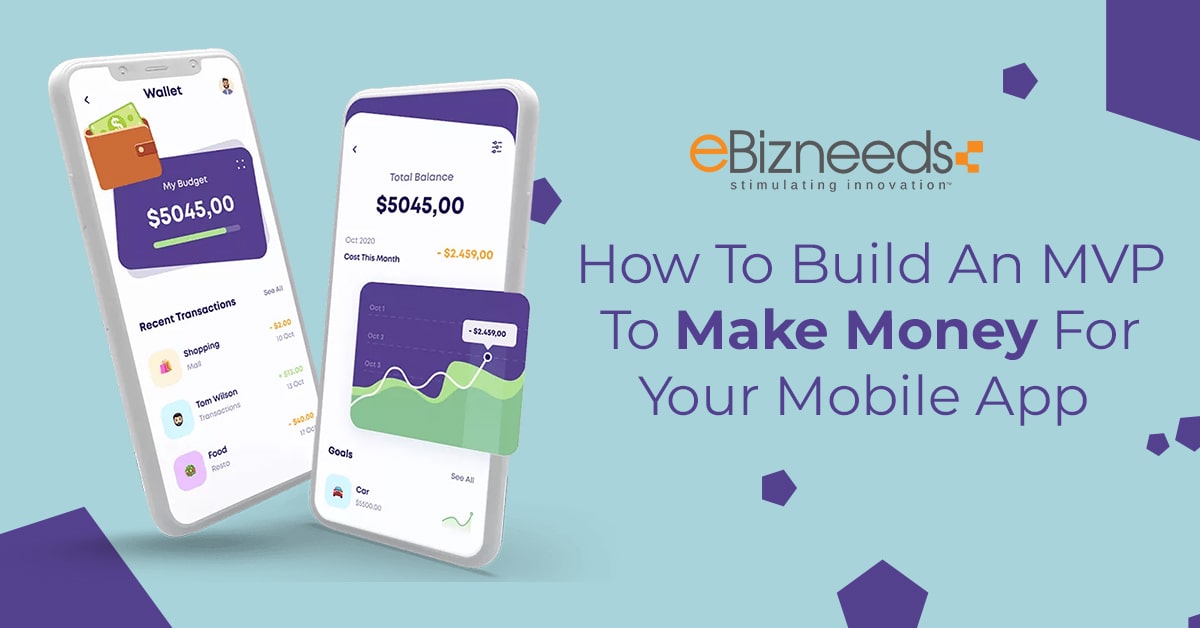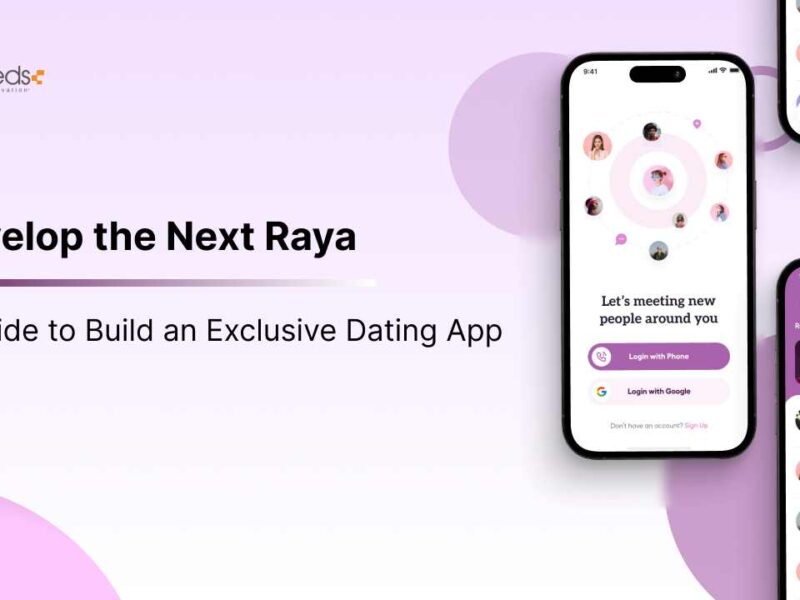Nowadays, companies are planning to have an idea for a product, but developing new products or services requires more money, and not all companies have enough money to implement their ideas.
In this situation, you need to know how to build an MVP to make money. By designing and developing the MVP, companies can test their ideas on real users and raise money to fund further MVP development.
According to Statista, approximately 25% of apps get unrestricted after a single use. Several apps are growing, and the competition is getting more challenging.
Developing an MVP is the best way to test the business idea, as it does not require more money. This blog will discuss creating an MVP to make money for your mobile apps. But before that, let’s take a closer look at what MVP is.
What is An MVP (Minimum Viable Product)?
MVP is defined as the development technique where a new product is launched in the market by utilising simple features that are adequate to attract customers’ attention. Before launching the final product in the market, you need to get proper feedback from initial users of the products.
MVP is the basic version of a product that you want to release. It has the necessary features to introduce them to customers. It also permits you to test the app’s response from its potential users.
Using the data obtained through MVP usage, you can assess the significance of the app in fulfilling its purpose and analyzing the gaps. It also helps to add or improve the features. Developing an MVP aids you in making the final product.



Why Develop MVP?
You would be surprised to know that a number of founders’ journeys ended before a single user held their product in their hands. It is a very basic circumstance. As a result, passing the MVP development procedure is critical to success.
Let’s discuss some other benefits of developing an MVP for mobile app.
Attention From the Investors
MVP is a technique to demonstrate your idea. It permits you to display your concept rather than talk about it for hours. Furthermore, when you find people who will use the products and get value from them, your investment potential skyrockets.
Build a Product that People Use
It is a complex case in which founders assume how the potential should look and stick to it. The main aspect is that this assumption must be highly elastic when developing a product for individuals.
By obtaining comprehensive feedback through users and MVP, you have chances to execute only significant features and remove everything that is not useful.
A Better Understanding of The Domain
When you want to develop an MVP in mobile app development, you initiate to look deeper into the issue, market, and industry. It helps you to obtain better domain knowledge as well as find out the space prospects. When you start developing a complete product immediately, you will miss it.
Fast & Affordable Idea Validation
MVP development necessitates the most basic features for validating ideas, as well as the least amount of time to complete. You can focus your time and resources on the most important aspects of the product. It is an inexpensive product that demonstrates how real users will respond.
A Place For Low-Risk Experiments
A minimum viable product provides you space for evolution. Initially, if some new technologies arise, you can assimilate them softly and fairly. Moreover, it is much simpler to include new features than to remove unnecessary ones.
Fundamentally, MVP keeps the product idea flexible for advanced transformations.
How to Build An MVP (Minimum Viable Product)?



MVP product development does not differ considerably from software product development. Although the stages are similar, the goal and speed of such steps have varied.
We will help you understand how to build an MVP as it will help to prepare for the difficulties.
Define A Problem Statement
It would help if you always initiated addressing the issue you want to address. You can transcribe it down. And, by using an MVP in mobile app development, you can assess its viability.
You can also validate the ideas without development as it is significant to save resources and ensure a requirement in your solution. In the industry, being a professional is beneficial, but you still must learn when the issue you want to address exists.
Conduct Market Research
In this step, you need to assess the market. It would help if you also explored the rivalries, addressed your target audience, conducted market research, and measured the market size.
Lack of good Money is the key cause of why startups are failed. Hence, before investing your money, you must research how many people are interested in your new product.
Prototype Potential Solution
You may ask why you need both software and prototype MVP. A prototype is an initial attempt to visualize the working solution, whereas an MVP is a basic product form that executes the target actions.
Along with this, prototyping puts the functionalities and design into the viewpoint. It also validates the UI & UX. And, lets you to get an early response for enhancements that you will consider in an MVP development services.
Steve Jobs developed the Apple Lisa and avoided the prototyping stages. Consequently, the product was unproductive and also catastrophic.
Listing Your App Features
As discussed above, you cannot make a product without knowing the customer’s needs and wants. For MVP product development, feedback must be gathered from customers as it is significant to raise money for your mobile apps.
By getting to know your potential customers, you would be able to add a list of features to your MVP to make money.
Along with this, a roadmap will be based on it. You can also hire mobile app developer to make listing of your app features.
Developing and Testing Your MVP
After defining the scope of your product and service, you must focus on the development procedure. You should test the software to check its efficiency in each stage.
The app developers will assist you when you work closely with them. Addressing the bugs and flaws in your application is a significant procedure before launching it.



Examples of Minimum Viable Products
Are you interested to know about what things should be consider while developing an MPV? If so, here are some example of mvp that went on to become successful mobile app development companies.
ZAPPOS
Before eCommerce was a developed concept, Nick Swinmurn had a brilliant idea that people would be content to shop for shoes online without going offline.
To test the hypotheses, Nick went to local shoe stores, clicked photographs of their stock, and advertised them online.
If the shoe has been sold, he will return to the store, purchase the shoes and deliver them. In a few years, eCommerce will become a multibillion dollar sector. Hence, Amazon has bought Nick’s business, Zappos for $1.2 billion.
This strategy is sometimes called ‘Flintstoning’. Although your product and services look fully functional and polished, you are pedalling like hell beneath the surface.
DROPBOX
Sometimes, you can test the fundamental assumption without developing the product. Before DropBox became a $10 billion global giant, it was a 3-minute video stuffed with unprofessional narration and intellectual in-jokes.
Founder Drew Houston felt that the level of time and energy essential for developing a functioning DropBox Prototype. Although it was extremely high, it needed to manage the complex integration with existing techniques.
Hence, instead of capitalizing on different resources to develop a functional version of the software for users to try, Drew has developed a simple video explaining how the software was envisioned to perform.
Despite the video’s simplicity, it caused an explosion related to interest and showed that once the DropBox concept is effectively executed, it would solve the enormously painful issues.
ANGELLIST
AngelList has focused on developing a simple website. It relies on its plain old email and existing contact networks to manage its first few investment opportunities. It avoids creating a complex website and spending a fortune to market itself to founders and investors.
After achieving small-scale success, it becomes easier to justify the resources and time required for scaling up the services. It helps to prove the fundamental assumption appropriately.
Development Mistakes to Avoid While Building an MVP
What are the common drawbacks you would be better sidestepping during the MVP app development for releasing a successful product?
Postponing Monetization to Future Product Updates
When you treat your MVP as a finished product from the start, why shouldn’t it have a sound monetization approach? Because your customers do not care if it is an MVP or another abbreviation; it is a finished product. You must focus on the given approach:
- Focus on monetization strategy at the initiation phase
- An application that relies on a subscription model tends to achieve sound
Too Many Or Too Few Features
You need to avoid adding too little or too much functionality. Every feature must deliver value and also have a direct effect on ROI. Development often occurs when an app owner gets extremely excited to see their app coming live.
They focus on early version and innovative ideas spring to life. Consequently, it is critical to assess what impact these creative ideas may have on cost, time to market, and ROI.
- Replace past planned options or postpone development when new features do not noticeably affect the ROI rather considering new features at the time of development.
Building Entirely from Scratch
Nowadays, software developers use a set of tools for MVP product development, such as open-source and commercial. There are a set of SDKs, libraries, APIs, and other code templates that assist you in realizing the features, such as mapping or chatting in days rather than months.
You can also use reliable third-party techniques to pick up the development pace.
Unfit Development Approach
Agile and lean methodology is suitable for creating an MVP. You risk releasing an app when you decide to use a fixed-price strategy and rigid structure for budget and delivery. Because there would be a lack of the product market fit and it cannot find all user needs and wants effectively.
When you develop the software, you need to make different assumptions about end customers and their behaviour. Consequently, agile permits you to verify those assumptions and adjust on the fly at the time of a project.
- You must ensure that the mobile app development company follows the agile principles as well as keeps you in the loop during the project
Ignoring the Marketing Budget
Another common mistake is that you ignore spending money on marketing activities and only focus on development investments to raise money. You must remember that day by day, more apps are appearing, and they all are competing to meet the customer’s needs.
So, it would be risky for you not to consider the marketing budget at the starting time. It doesn’t matter how your product is better; it will not sell itself until individuals have seen it.
- You must assess your marketing budget before you initiate an MVP project
Lack of Analytics Post-Launch
After launching an MVP, You will need to assess its performance. You need to evaluate it in terms of active subscription and user base. You must integrate with the app analytics services such as Mixpanel and Flurry. Consequently, MVP lets you gather all this data when the app is live.
- Integrate your app with an app analytics service earlier
Ways to Measure Success After Building An MVP
There are different approaches for predicting the product’s future success correctly. Let’s discuss some ways to measure the success after building an MVP:
Feedback-based Client Appraisals
The Number of downloads and launch rates demonstrates users’ interest in the app. Customers will download more based on the simplicity of the app.
Engagement
It helps a startup for measuring not only product’s present value but also potential value. Engagement aids you in enhancing the user experience based on the feedback.
Word of Mouth
Traffic is a valuable metric for predicting success. Another way to track success is by interviewing possible customers. You may start by listing the issues a customer is facing or is likely to face and then ask what they think.
Sign-Up
It is another possible manner for gauging user interest. They also transform to revenue based on measuring needs in the product.
Client Acquisition Cost (CAC)
It is vital to understand how much it costs to attract the attention of paying customers. It will support startups to keep updated on their marketing initiative and make changes whether it is required.
CAC = money spent on traction network / Number of customers acquired by the channel.
Percentage of Active Users
Launch rates and downloads are not the only factors that assess the success of an MVP. It is significant for researching users’ behaviour and evaluating regularly active users’ ratings.
Churn Rate
It indicates the percentage and level of individuals who have stopped or uninstalled using the application.
Churn = Number of churns per week or month / Number of users starting the week or month.
Client Lifetime Value (CLV)
CLV depicts how much time a user spends on the application before uninstalling or discontinuing their application use.
CLV = (Profit from a user *App usage duration) – Acquisition cost
Number of Paying Users
Understand the average revenue per user and keep product track that will provide you with payment.
The average revenue per user = Total income for the day and age/Number of active users
Cost for MVP App Development
It generally requires between $100k to $150k to develop an mvp for startups. But, your budget will fully rely on the key feature you envision.
As you can visualize, the MVP with machine learning or other sophisticated functionality will need a highly substantial effort compared to an average patient app. It generally takes minimum time and a low budget.
Different variable factors are considered in MVP app development, so app development costs vary. Some of the essential elements believe given below:
- Hourly Rate of developer
- Functionalities and features you add to app
- The technology stack that you consider
- Usage of third-party services
- Scope of design and development task
But, we will now assess the MVP app development timeline according to different app types.
Indeed, we also have experience developing MVP apps for clients globally, such as on-demand, weather, and dating apps. You can emphasize the weather apps we have created for a client. Over 150k users download it in just a year after the launch.



List of Tech Stack for a Successful MVP
You should figure out the feasible tech stack essential in your MVP software development. Let’s focus on some of the good alternatives:
Frontend interface – Angular.js, Vue.js, and, React.js
|
Frontend interface |
Benefits |
|
Angular.js |
|
|
Vue.js |
|
|
React.js
|
|
Backend interface – Node.js, Ruby on rails, and Python
|
Backend interface |
Benefits |
|
Node.js
|
|
|
Ruby on rails |
|
|
Python/Django |
|
Cross-platform technology- Google Flutter and React Native
|
Cross-platform technology |
Benefits |
|
Google Flutter |
|
|
MVP in React Native |
|
Closing Thoughts
Developing an MVP for mobile app is a significant process to raise money. Considering the tips discussed in this post, you can create a product that will vibrate the investors. It will also help secure the funds required to take your application to the market.
Also, let’s focus on great companies such as Airbnb, Uber, and WhatsApp initiated as MVPs and now are the most productive ones. Hence, do not let little things discourage you from seeking out investors for MVP.
FAQs
An MVP is a product with adequate features for motivating early adopters and substantiating a product idea at starting of development cycle. MVP enables the product team for acquiring the user feedback promptly. Hence, the product can be enhanced and redone.
A prototype is a fast way to test products’ fundamental concepts and assumptions. In contrast, an MVP is an applied product version that only considers key features. It is perfect for testing that offers valuable data and feedback. But at this stage, you must invest the least time and money.
You can initiate your MVP journey with such steps:
Defining the Problem Statement
Conducting Market Research
Prototype the Potential Solution
Listing your app features
Developing and testing your MVP
MVP software development completely relies on the design complexity, feature set, and human resources involved in the procedure, generally about 3-5 months.



Naveen Khanna is the CEO of eBizneeds, a company renowned for its bespoke web and mobile app development. By delivering high-end modern solutions all over the globe, Naveen takes pleasure in sharing his rich experiences and views on emerging technological trends. He has worked in many domains, from education, entertainment, banking, manufacturing, healthcare, and real estate, sharing rich experience in delivering innovative solutions.


